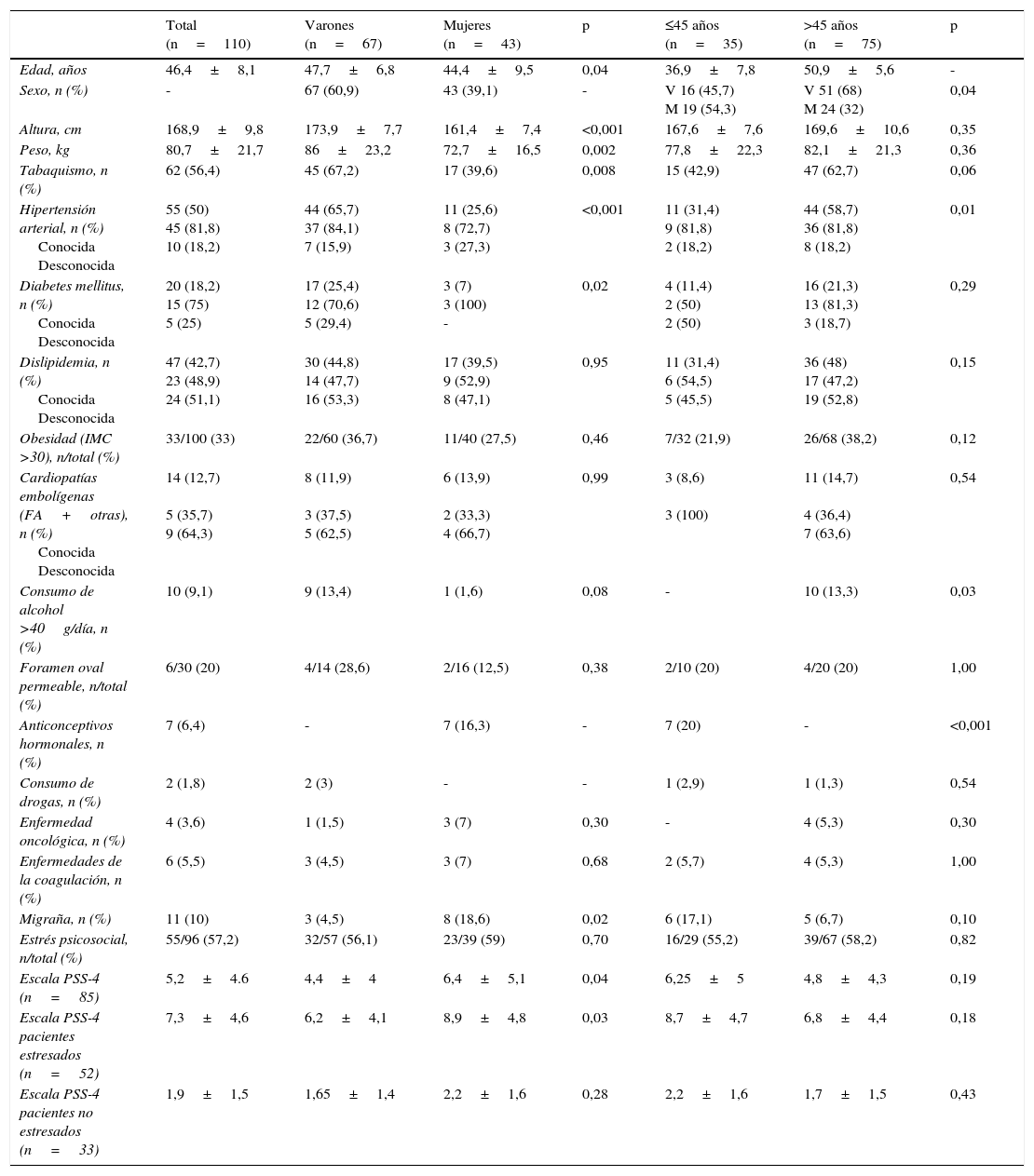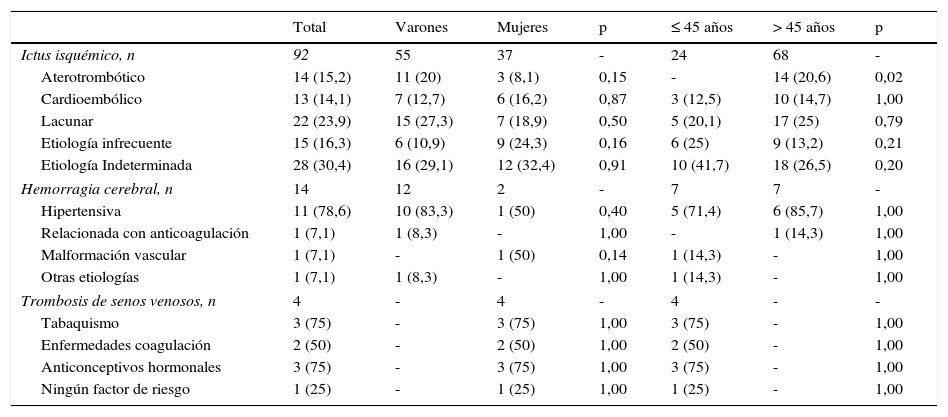Analizar la incidencia, los factores de riesgo, la etiología, el tratamiento y la evolución clínica de pacientes jóvenes con ictus.
Pacientes y métodosRegistro retrospectivo de pacientes ≤ 55 años ingresados en una Unidad de Ictus durante el año 2014. Se recogió la incidencia sobre el total de ictus y se analizaron datos demográficos, factores de riesgo, grado de estrés, tipo y etiología del ictus, tratamientos de reperfusión y evolución clínica.
ResultadosSe incluyó a 110 pacientes, la mayoría hombres (60,9%, ratio 1,6:1). La incidencia fue del 13,3% (110 de 830 ictus). La mayoría de los pacientes tenía factores de riesgo vascular. El tabaquismo fue el más frecuente (56,4%), seguido de la hipertensión arterial (50%), dislipidemia (42,7%), obesidad (33%), diabetes (18,2%) y cardiopatías embolígenas (12,7%). El 64,3% de las cardiopatías y el 51,1% de las dislipidemias se descubrieron durante el ingreso. El 57,2% de los pacientes presentaban estrés psicosocial en la etapa previa al ictus. El 83,6% de los ictus fueron isquémicos, el 12,7% hemorrágicos y el 3,6% trombosis de senos venosos. De los ictus isquémicos, el 30,4% fueron criptogénicos, el 23,9% lacunares, el 16,3% por causas infrecuentes, el 15,2% aterotrombóticos y el 14,1% cardioembólicos. El 78,6% de las hemorragias cerebrales fueron hipertensivas. El 23,3% de los ictus isquémicos recibieron tratamientos de reperfusión en fase aguda y se consiguieron niveles de independencia funcional a los 3 meses del 62,5%.
ConclusionesLa mayoría de los ictus en pacientes ≤ 55 años parecen relacionarse con una elevada prevalencia de factores de riesgo vascular clásicos y posiblemente de estrés psicosocial.
To analyse the incidence, risk factors, aetiology, treatment and clinical evolution of young patients with stroke.
Patients and methodsRetrospective registry of patients aged 55 years or younger hospitalised in a stroke unit during 2014. We recorded the incidence rate for all strokes and analysed demographic data, risk factors, degree of stress, stroke type and aetiology, reperfusion treatments and clinical evolution.
ResultsThe study included 110 patients, the majority of whom were men (60.9%, 1.6:1 ratio). The incidence rate was 13.3% (110 of 830 strokes). Most of the patients had cardiovascular risk factors. Smoking was the most common risk factor (56.4%), followed by arterial hypertension (50%), dyslipidaemia (42.7%), obesity (33%), diabetes (18.2%) and emboligenic heart disease (12.7%). Some 64.3% of the heart disease cases and 51.1% of the dyslipidaemia cases were discovered during hospitalisation. Some 57.2% of the patients experienced psychosocial stress in the stage prior to the stroke. Some 83.6% of the stroke cases were ischaemic, 12.7% were haemorrhagic and 3.6% were venous sinus thrombosis. Of the ischaemic stroke cases, 30.4% were cryptogenic, 23.9% were lacunar, 16.3% were from uncommon causes, 15.2% were atherothrombotic and 14.1% were cardioembolic. Some 78.6% of the cerebral haemorrhage cases were hypertensive. Some 23.3% of the ischaemic stroke cases underwent reperfusion treatments in the acute phase, achieving levels of functional independence at 3 months of 62.5%.
ConclusionsThe majority of stroke events in patients 55 years of age or younger appear to be related to a high prevalence of classical cardiovascular risk factors and possibly to psychosocial stress.
Artículo
Diríjase desde aquí a la web de la >>>FESEMI<<< e inicie sesión mediante el formulario que se encuentra en la barra superior, pulsando sobre el candado.

Una vez autentificado, en la misma web de FESEMI, en el menú superior, elija la opción deseada.

>>>FESEMI<<<












